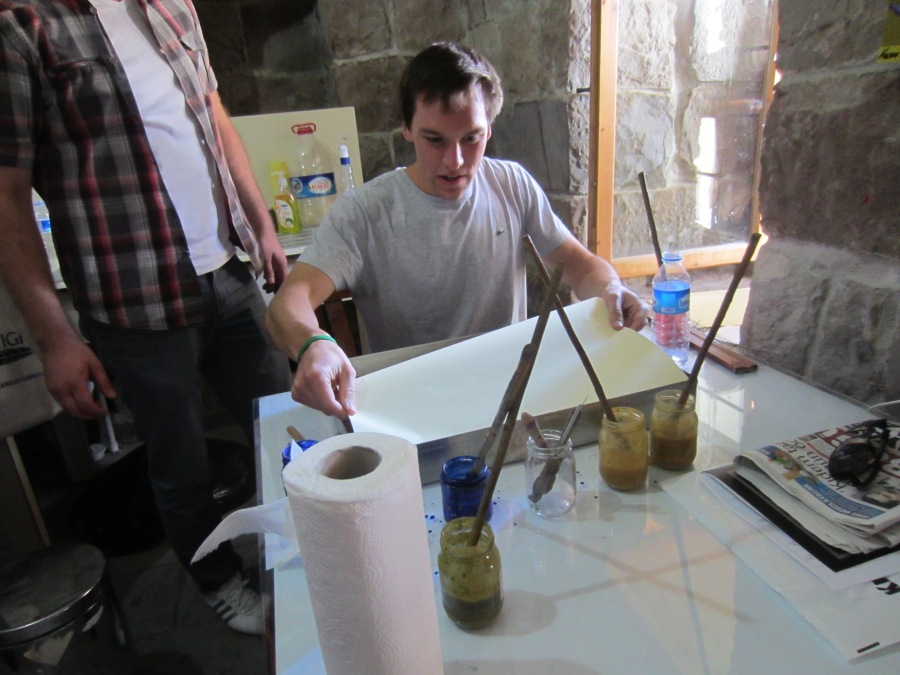
While visiting the caravanserai of Silahatar Mustafa Paşa Hanı in Battalgazi, Malatya, I was privy to an intimate and impromptu demonstration of the classical Turkish art form known as ebru (sometimes known as water painting or marbling). The oldest determinable ebru works date from the early to mid-1500s; traditionally ebru was used as the media for calligraphy, though many styles and forms now exist.
The tools used in ebru are highly specific to the craft, including
- Specially-designed horse hair or rose stalk brushes, whose stiff bristles are ideal for the flicking method at the heart of the craft;
- a viscous substance, traditionally made from gum tragacanth, though many other contemporary options, like Irish moss, are used (henceforth referred to as “the sticky stuff;”
- “paint” comprised of aqueous natural pigments, which are mixed with;
- ox-gall (used as something of a paint thinner);
- Special paper;
- Various metal tools used in the post-paint application phase
The artist begins with a clean rectangular tray of the sticky stuff:
 A variety of colors can be used. Paint is applied through a highly controlled flicking motion, in which a small amount of thin paint is put on the horse-bristle brushes, which are then rapidly tapped along the hand of the painter, as shown.
A variety of colors can be used. Paint is applied through a highly controlled flicking motion, in which a small amount of thin paint is put on the horse-bristle brushes, which are then rapidly tapped along the hand of the painter, as shown. 
 They were way ahead of Jackson Pollack on this, by the way. Various colors are applied in succession. As the paint hits the “goo” it dissipates within it, creating concentric clouds of color which interact but retain the general shape and location to where they were applied (flicked, spattered).
They were way ahead of Jackson Pollack on this, by the way. Various colors are applied in succession. As the paint hits the “goo” it dissipates within it, creating concentric clouds of color which interact but retain the general shape and location to where they were applied (flicked, spattered). 
 Once all of the colors have been applied to the goo in this way, the artist uses a fine metal tool, almost like something you’d see at the dentist’s office, to alter the paint’s dissipation. Cutting through the goo in a relatively slow, careful manner, they create a series of parallel lines, first horizontally, and then vertically. Doing so alters the form of what were previously clouds or bubbles of color into a more geometric [read: psychedelic] pattern.
Once all of the colors have been applied to the goo in this way, the artist uses a fine metal tool, almost like something you’d see at the dentist’s office, to alter the paint’s dissipation. Cutting through the goo in a relatively slow, careful manner, they create a series of parallel lines, first horizontally, and then vertically. Doing so alters the form of what were previously clouds or bubbles of color into a more geometric [read: psychedelic] pattern.
 After this step, a fine metal comb which fits the pan is quickly and smoothly (to prevent air bubbles or other distortions of the pattern) run through the goo, further altering the swirling painted pattern.
After this step, a fine metal comb which fits the pan is quickly and smoothly (to prevent air bubbles or other distortions of the pattern) run through the goo, further altering the swirling painted pattern.
Next, the special absorbent paper is carefully and, again, quickly, placed on top of the goo, and another metal dentist-like utensil is lightly run over it to remove any air bubbles and ensure even application. Next, the edges of the paper are delicately lifted, and dragged across the lid of the pan. In this process, all of the paint, which in procedure appeared to be clouded deep within the goo, is directly applied to the paper, with little to no residue in the pan of goo. 
 Amazing.
Amazing.
Many other, more detailed manipulations of the paint can result in images of objects, such as the popular floral ebru, which today is perhaps the most common style/form.

One of my fellow Fulbrighters seized the opportunity to give it a try for himself, and they even whipped out a beautiful blue paint for him to use. The results are gorgeous!







One thought on “Do Ebru”